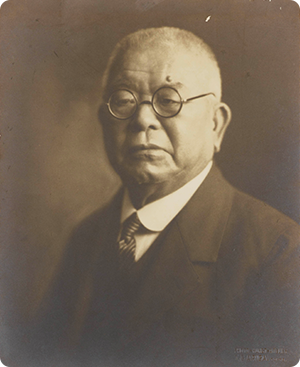Serum therapy
Characteristisof Shibasaburo Kitasato

No reproduction of photos
Photo courtesy of Kitasato Institute
Shibasaburo Kitasato
Dr. Shibasaburo Kitasato is known as the “father of modern Japanese medicine. His greatest achievement is probably the world’s first pure culture of tetanus bacteria. Dr. Shibasaburo Kitasato accomplished this feat only three years after studying in Germany. However, the experiment was a series of hardships. At the time, the prevailing theory in Germany was that it was impossible to cultivate pure tetanus bacteria.
Kitasato took a small hint and discovered that tetanus bacteria are anaerobic, meaning that they do not like oxygen.
Kitasato immediately built his own bacterial culture apparatus that could exclude oxygen, and in 1889, he finally succeeded in cultivating pure tetanus bacteria. In 1889, he succeeded in culturing pure tetanus bacillus, and the following year, he devised a serum therapy for tetanus. Kitasato’s serotherapy was later applied to the treatment of diphtheria, and saved many lives.
Serumtherapy is defined as the treatment by administering serum (also called antitoxin or antiserum) containing artificially produced polyclonal antibodies (human or other animal). (*1)
The history of serumtherapy dates back to 1890 when Shibasaburo Kitasato and Emile Behring jointly announced the discovery of serotherapy in their paper “On the Serotherapy of Diphtheria and Tetanus in Animals”. (*2)
Although Behring alone was awarded the first Nobel Prize in Physiology or Medicine in 1901 for his achievements, it goes without saying that Kitasato also laid the foundation for serumtherapy.
※1 Park WH. Serum therapy. Bull N Y Acad Med 1931;7:401-11. ※2 von Behring E, Kitasato S. Ueber das Zustandekommender Diphtherie-Immunität und der Tetanus-Immunitätbei Thieren. Deutsche Medicininischen ochenschrift1890;49:1113-4.
History of Serumtherapy
- 1. serumtherapy began with the cultivation of tetanus bacteria by Dr. Shibasaburo Kitasato in 1889.
- 2. In 1901, Dr. Baring was awarded the first Nobel Prize in Physiology or Medicine (the research was done in collaboration with Dr. Kitasato).
- 3. currently available for clinical use in Japan under three frameworks: government-owned products, commercial products, and clinical research.
- 4. its efficacy is being investigated in Ebola hemorrhagic fever, severe febrile thrombocytopenia syndrome (SFTS), etc.
- 5.It is also being investigated for the treatment of new coronavirus infections (COVID-19).